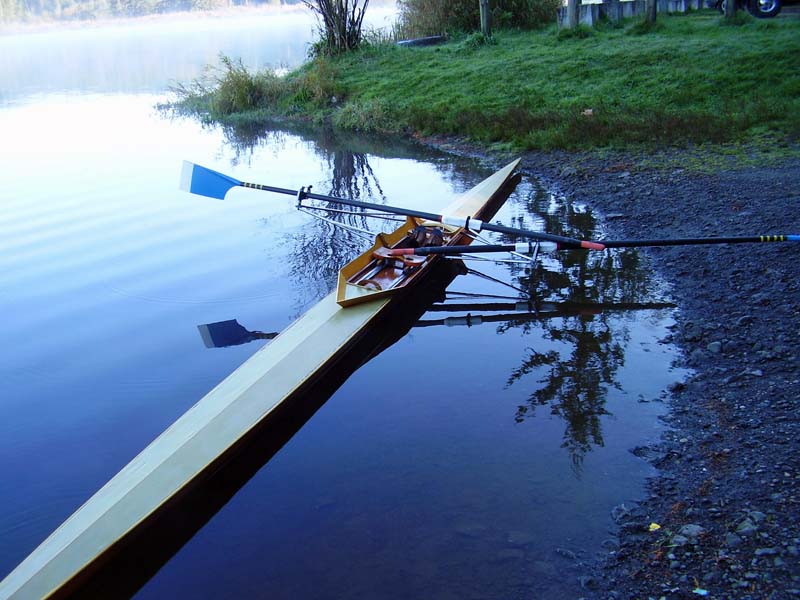Blakeley
An Early 1960's Lightweight Teardrop Pocock Single
| Blakeley My father, Dan, had the boat on display at the Expo Center in Portland in January of 2009 at a Home and Garden Expo with the craft guild he was associated with at the time. At the expo, a man approached the boat with his granddaughter, and started telling his daughter all about the boat. After a few minutes, Dan asked him what they were talking about, and the girl said that her grandfather had worked at Pocock during the early 1950’s, and he had told her that he had made wheels similar to those on our boat. Dan asked him if he knew how old the boat was, and he thought it was from pre-WWII. He called it an ‘early Pocock’. Dan took the boat to an alumni row at the OSU campus, in the hopes of finding more information about its history. A man there said that in the early 60’s there were three coxswains on the men’s team who all wanted to row. And so all three of them got matching lightweight Pocock singles, and that the Blakeley was one of those three shells. This is the man who recognized it as the Blakeley, where previously we had not known the name of the boat. He thought that the boat had been named after someone who had died in WWII, because it was common practice in that time to name boats after fallen soldiers. Oral History Dan also talked to a former coach of the OSU women’s crew team, who is now retired and living in Walla Walla, WA. The former coach confirmed the name, and remembers that the boat was built by George Pocock himself for a specific person, but he couldn’t recall the name of the person it was designed for, or the age of the single. Personal History Dan got the boat from David Fredericks, the Freshman coach of the men’s team, at the time, who had heard that the boat had been stripped in 1989, in the hopes of making the boat lighter. But the project was abandoned and the boat was left in the barn abandoned until Dan took it to restore in 2005. At OSU there is a workshop that is used to work on boats, and this is where David Fredericks helped Dan find all the pieces that fit onto the boat- tracks, riggers, foot stretchers, seat, etc. They may not have been the original pieces, but the ones found fit well onto the boat, and seemed to be the right era. When Dan first found the boat, it had no decking, and no hardware attached to it. It was just the hull and the internal framing and the seatbox. The planking had many cracks in it, as a result of being stripped and left alone for so many years. Dan went and bought 100 ft. of bubble wrap and wrapped the whole boat in bubble wrap and taped it up and loaded onto his truck and drove it up to Portland where he spent about 2 ½ months full time in restoring the boat. I bought the boat from Dan the fall of the following year, after he realized that the boat was not a size that could withstand his weight. After that, I rowed the boat to my boathouse on the Willamette River in Lake Oswego, where I and a couple other juniors on my rowing team took it out every once in a while. Two years later I was forced to move it because they needed the rack space for other boats, so I rowed it back to ORU in Portland, where I have kept it since then. I’ve only rowed it a couple times since I moved it back to Portland, which is what prompted my decision to sell it. But it is in the same condition that it was in after restoration, because Dan as touched up flaws from minor dings and scratches as they came along. Outstanding Features The hull is made from a single piece of Western Red Cedar wood and the port side and the starboard side were cut from the same plank and then split so that they could be bookmatched and identical on both sides. This way, if there is a stress on one side of the boat, there will be an equal stress on the other side, which prevents the hull from wanting to twist or bend out of shape. Dan has now restored 5 wooden racing shells, three of which were Pococks, and the Blakeley is the only boat where each of the struts, frames, stringers, and all of the pieces of wood in the boat were carved away by hand, in an effort to make it extra light. There is no indication that this was done by anyone other than Pocock, since the pieces of wood that had been lightened were impossible to get to without removing all of the decking and taking the boat completely apart. Steve Chapin confirmed that w/o the usual Serial Numbers it's a pre early 1960s shell. This is a fast boat. Sue won her age bracket at the Head of the Lake 2010 regatta in it. Best Richard See Jesse and Don Pence comments and pictures. |

Back to Fleet
Pocock Singles Project
Copyright 2005 - 2012 Wooden Boat Foundation
All rights reserved.
webmaster
